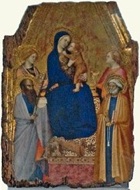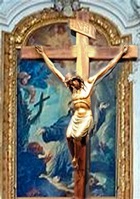

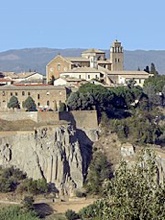
A Franciscan hermitage was established outside Orvieto (probably at San Pietro in Vetere) before 1217. The friars began the construction of the present church in 1234 on what had been the site of a Benedictine monastery beside the ancient church of Santa Maria della Pulzella.
When the Blessed Ambrose of Massa died at San Pietro in Vetere in 1240, his cult quickly became established. Pope Gregory IX, who supported the development of the cult, also granted privileges to the friars in 1240. The consequential revenue supported the completion of the new church (originally dedicated as SS Francesco e Ambrogio) and the adjacent convent. The friars apparently moved here in 1243.
In 1256, Pope Alexander IV granted indulgences to those celebrating the feasts of SS Francis, Antony of Padua and Clare at San Francesco. He also complained about the indecency of the place in which the relics of the Blessed Ambrose were interred, which led to their translation to a more fitting location in 1257. [Where are they now ?]
According to tradition, St Bonaventure, the Minister General of the Order, arranged for it to be enlarged during his stay in the convent in 1262-4. Pope Clement IV consecrated the new church (dedicated now simply as San Francesco) in 1266. At this time, San Francesco was the largest church in Orvieto and many important events took place here while the Duomo was in construction.

-
✴In 1273, Pope Gregory X officiated here at the funeral of Henry of Cornwall, (whom Guy de Montfort had murdered) and Charles d’ Anjou, King Edward I of England and his wife, Eleanor of Castile attended the service.
-
✴In 1297, Pope Boniface VIII canonised St Louis IX of France in the church.
The Franciscans were moved to the Seminario Vescovile in 1815 and then to Sant' Agostino in the following year. The convent was used as a military complex in the period 1878-1955.
The deconsecrated church was reopened to the public in 1999, after a long period of closure. Part of the convent is to be adapted to house the Biblioteca Comunale.
Exterior
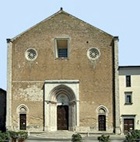
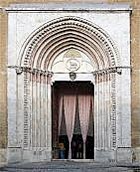
Part of the convent and the “new” campanile stand to the right of the church
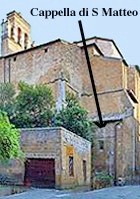
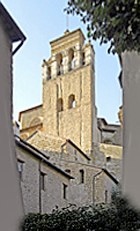
Convent
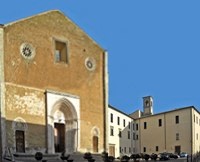
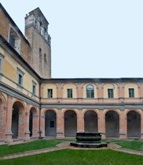
Ippolto Scalza rebuilt part of the convent, including the cloister in 1580. This cloister can be seen from inside the Biblioteca Luigi Fumi, which moved to the part of the convent to the right of the church in 2009. The Istituto Storico Artistico Orvietano moved to the part at the far end of Piazza Febei in 2011.
The Ristorante al San Francesco, behind the church, occupies another part of the ex-convent.
Interior of the Church
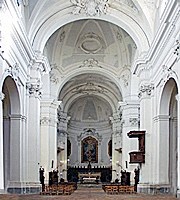
The interior was originally in the form of a “Hallenkirchen” (preaching church). However, it was completely remodelled in 1768-73, when the width of the nave was reduced by the installation of the colonnades to form interconnected side chapels. The existing cupola was raised at this time above what was now a transept.
Statues of Pope Boniface VIII (ca. 1300)
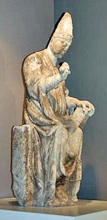
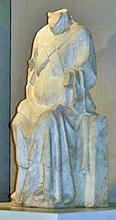
Figure from Porta Maggiore Figure from Porta Postierla
When the Commune wanted to honour Pope Boniface VIII in 1297, it commissioned these marble statues (now in the left aisle) for the niches in two of the city gates:
-
✴the one from Porta Maggiore is attributed to Ramo di Paganello; and
-
✴the other from Porta Postierla is attributed to his presumed associate, Rubeus.
These figures, which were removed in 1860, are both badly damaged. The former, however, still retains its head and arms: the right arm is raised in blessing and the left hand holds a book that has been identified as the Liber Sextus delle Decretali (1298). The form of headgear is that adopted by Boniface VIII after he had inaugurated the first Jubilee Year in 1300.
Crucifix (ca. 1320)
St Jerome (1580)
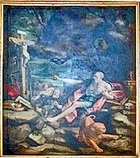
Altarpieces by Cesare Nebbia (16th century)
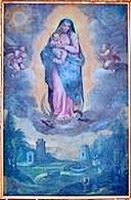
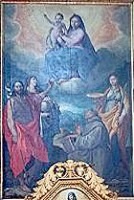
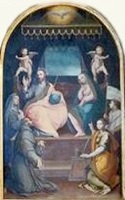
Immaculate Conception Madonna and Child in glory Entombed Christ with the Virgin
Three altarpieces in San Francesco are by or attributed to Cesare Nebbia:
-
✴the Immaculate Conception (1584) on the second altar on the left;
-
✴the Madonna and Child in glory with SS John the Baptist, Mary Magdalene, Lucy (with her eyes on a plate) and a Franciscan saint, on the third altar on the left; and
-
✴Christ in judgment, emerging from his tomb holding the world in his left hand, with the Virgin and SS Francis, Clare, George and Barbara, on the fourth altar on the left.
Panels by Filippo Naldini (ca. 1773)
The Saracinelli family commissioned three panels in the presbytery from Ludovico Mazzanti during his stay in Orvieto in 1757-68. However, he effectively retired in 1762, and the works are attributed to Filippo Naldini and other followers. They depict:
-
✴the [vision of St Gregory IX];
-
✴the stigmatisation of St Francis; and
-
✴the Virgin offers the baby Jesus to [St Antony of Padua], with [St Nichols] below, which includes the Saracinelli arms.
Two other panels in San Francesco that are attributed to Filippo Naldini:
-
✴The panel of St Joseph of Copertino (who had been canonised in 1767) on the 1st altar on the right bears the arms of the Pollidori family.
-
✴The panel of the death of St Joseph, which is between the 2nd and 3rd altars on the right, [is dated by inscription to 1773].
Cappella di San Matteo (late 14th century)
This chapel to the left of the presbytery, which was built at the base of the then campanile, was restored as much as possible to its original state in 1999. A series of frescoes was re-discovered under a layer of plaster during this restoration. The frescoed frieze includes the arms of the Benincasa family.
Scenes from the life of St Matthew (late 14th century)
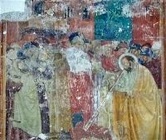
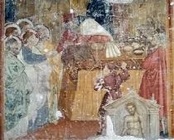
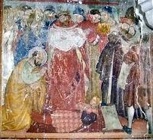
These frescoes of three scenes from the life of St Matthew on the back wall of the chapel are attributed to Pietro di Puccio. They depict:
-
✴the calling of St Matthew (a composition that is important for its precocious attempt at perspective and the last for the realism of the expressions); and
-
✴two stories from the Golden legend of Jacobus de Varagine:
-
•St Matthew disables two dragons in Ethiopia by making the sign of the Cross and, commanding, according to the inscription, "In the name of God, go and leave the people in peace"; and
-
•St Matthew resuscitates the son of King Egippus of Ethiopia, an event that led to the king’s conversion and inspired the formation of the Coptic church.
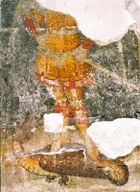
Art from the Church
Panel from San Francesco Polyptych (ca. 1325)
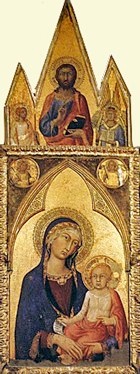
-
✴The scene in the pinnacle depicts Christ the Redeemer, with one hand raised in blessing and the other holding a closed book. Each of the smaller gabled fields to the side contains an angel. Inscriptions below identify Christ as ALPH- & O (Alpha and Omega) and the angels, respectively as ..RAP-YM (Seraphim) and CERUB-M (Cherubim).
-
✴The main part of the panel below depicts the Madonna and Child. The angels in the tondi in the spandrels are identified as TRONE (Thrones).
The types of angels depicted here (Seraphim, Cherubim and Thrones) form the highest order of the hierarchy of angels. It is likely that angels depicted in the lost panels were also taken from the defined orders of angels.
This panel almost certainly came from a polyptych, but the other components have been lost. A panel of St Catherine of Alexandria that is now in the National Gallery of Canada, Ottawa is thought to have been among them.
Panel from a Diptych (ca. 1350)
